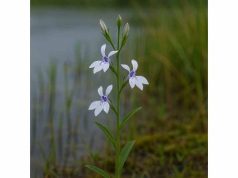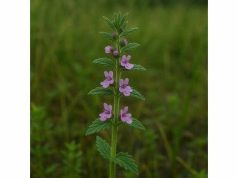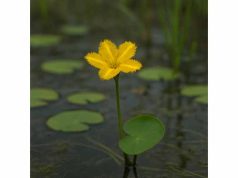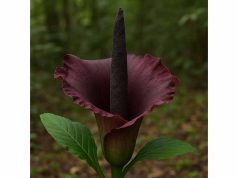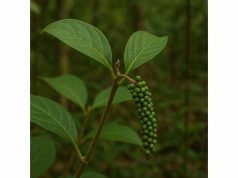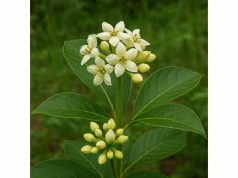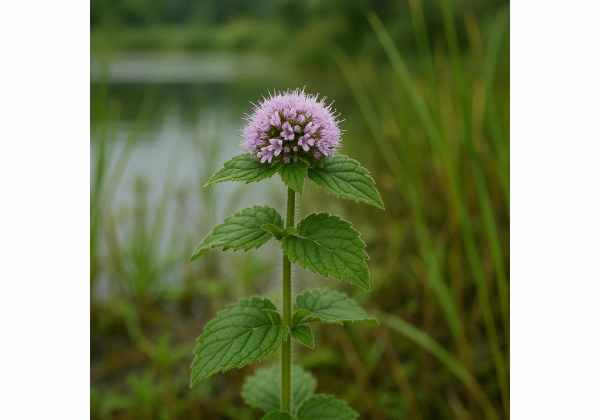
Water Mint (Mentha aquatica) is a fragrant, fast-growing perennial that thrives along streambanks, marshes, and pond edges. Renowned for its cooling menthol-rich essential oils, this versatile herb offers digestive relief, respiratory ease, and soothing skincare benefits. Its key active compounds—including menthol, menthone, rosmarinic acid, flavonoids, and tannins—work in synergy to deliver anti-inflammatory, antimicrobial, and antioxidant actions. From invigorating teas and steam inhalations to topical compresses and culinary accents, Water Mint’s medicinal properties and Water Mint benefits have cemented its place in traditional and modern herbalism. Whether you’re exploring digestive tonics or aromatic bath blends, this herb invites you to harness its refreshing energy and holistic wellness support.
Table of Contents
- Botanical Characteristics and Ecological Setting
- Active Chemical Profile and Principal Ingredients
- Health Advantages and Essential Virtues
- Utilization Methods and Safety Considerations
- Research Insights and Critical Findings
- Common Questions and Simple Answers
Botanical Characteristics and Ecological Setting
Water Mint (Mentha aquatica) belongs to the Lamiaceae (mint) family and is native to Europe, Western Asia, and North Africa. This herbaceous perennial spreads via creeping stolons and forms dense mats in damp soils or shallow water up to 20 cm deep. Stems are square and erect, typically reaching heights of 30–60 cm. Leaves are opposite, ovate to lanceolate, with toothed margins and a distinctive cool aroma released when crushed. Tiny lilac–purple flowers cluster in whorled spikes from mid to late summer, attracting bees, butterflies, and hoverflies.
Habitat Preferences
- Soil & Moisture: Prefers wet, loamy soils; tolerates partial submersion.
- Light: Thrives in full sun to partial shade; flowering peaks with at least 4–6 hours of direct sun.
- pH Range: 6.0–7.5 (neutral to slightly acidic).
Geographical Distribution
- Europe: Widespread from the British Isles through Central Europe.
- Asia/Africa: Extends into temperate zones of Western Asia and North Africa.
- North America: Naturalized in wetlands and riparian zones in the United States and Canada.
Ecological Roles
- Pollinator Magnet: Nectar-rich spikes feed bees and butterflies.
- Erosion Control: Dense root mats stabilize streambanks.
- Water Quality: Uptakes excess nutrients, helping to curb algal blooms.
Cultivation & Harvesting
- Propagation: Divide rhizomes in spring or take stem cuttings in water.
- Maintenance: Trim back after flowering to encourage fresh growth and prevent seeding.
- Harvesting: Pick leaves before flowering for maximum essential oil content; harvest flowers as they open for aromatic petals.
Water Mint’s adaptability and rapid growth make it a staple in water gardens, rain gardens, and naturalized wetland plantings, where it contributes both beauty and ecological benefits.
Active Chemical Profile and Principal Ingredients
The powerful medicinal properties of Water Mint stem from a rich assembly of bioactive constituents. Below is an exploration of its core compounds:
- Menthol
The signature monoterpene alcohol responsible for Water Mint’s cooling sensation. Menthol activates cold-sensitive receptors in the skin and mucous membranes, providing a refreshing, analgesic effect in topical applications and inhalations. It also acts as a mild decongestant by soothing irritated airways. - Menthone
A closely related monoterpene ketone that complements menthol’s cooling action. Menthone exhibits anti-inflammatory and antimicrobial properties, enhancing Water Mint’s effectiveness against skin irritations and minor infections when applied in salves and lotions. - 1,8-Cineole (Eucalyptol)
A cyclic ether known for its expectorant and bronchodilator effects. Found in varying concentrations, 1,8-cineole helps loosen mucus in the respiratory tract, supporting easier breathing in cough and cold remedies. - Rosmarinic Acid
A potent polyphenol offering antioxidant and anti-inflammatory benefits. Rosmarinic acid scavenges free radicals and inhibits pro-inflammatory enzymes, protecting cellular membranes from oxidative damage and reducing tissue swelling. - Flavonoids (e.g., Luteolin & Apigenin Glycosides)
These compounds contribute to Water Mint’s antioxidant capacity and vascular-supporting actions. Luteolin displays antihistamine effects, reducing allergic responses in the respiratory tract. Apigenin promotes mild relaxation and supports healthy sleep patterns. - Tannins
Natural astringents that tighten tissues and tone mucous membranes. Internally, tannins help reduce mild diarrhea by contracting intestinal lining; externally, they aid in skin firming and the reduction of puffiness. - Ursolic Acid
A triterpenoid with anti-inflammatory and antimicrobial properties. Ursolic acid enhances cellular health and may support muscle recovery when consumed as herbal infusions post-exercise. - Mucilaginous Polysaccharides
Gel-forming fibers that coat and soothe irritated mucous membranes in the throat and digestive tract. They provide protective barriers, reducing cough reflex sensitivity and calming mild gastritis or heartburn. - Trace Minerals (Iron, Magnesium, Calcium)
Present in small but beneficial amounts, these minerals support enzymatic reactions, muscle function, and electrolyte balance when Water Mint is consumed as a nourishing tea. - Essential Oil Fraction (Limonene, Pinene Traces)
Subtle monoterpene hydrocarbons add to Water Mint’s aromatic profile and may contribute additional antimicrobial and anti-inflammatory activities in complex herbal blends.
Together, these active compounds collaborate to produce Water Mint’s signature healing properties, making it a multipurpose herbal ally for respiratory comfort, digestive ease, skin health, and general vitality.
Health Advantages and Essential Virtues
Water Mint’s versatile benefits and properties extend across several body systems. Here are its primary wellness applications:
- Digestive Relief & Spasmolytic Action
Menthol and menthone relax smooth muscle in the gastrointestinal tract, reducing cramps, gas, and bloating. A cup of Water Mint tea after meals can ease occasional indigestion and promote healthy digestion. - Respiratory Comfort & Expectorant Effects
1,8-cineole and menthol act as mild bronchodilators and expectorants, loosening mucus and soothing coughs. Steam inhalation of Water Mint-infused water clears nasal passages and supports bronchial health. - Anti-Inflammatory & Antioxidant Support
Rosmarinic acid and flavonoids neutralize free radicals and inhibit inflammatory pathways. These antioxidants protect lung and digestive tissues from environmental stressors and promote healthy aging. - Antimicrobial Activity
Essential oils and phenolic compounds exhibit bacteriostatic and fungistatic effects. Topical creams with Water Mint extract can help manage minor skin infections, insect bites, and athlete’s foot. - Analgesic & Cooling Sensation
Menthol provides a cooling analgesic effect when applied to the skin, easing tension headaches, muscle soreness, and joint discomfort in massage oils or balms. - Astringent & Skin-Tightening Actions
Tannins and ursolic acid contract tissues, reducing puffiness under the eyes and toning sagging skin. Water Mint-infused toners or compresses leave skin feeling refreshed and firm. - Diuretic & Detoxifying Aid
Mild diuretic properties support fluid balance and urinary tract health. Drinking Water Mint tea helps flush excess fluids, aiding in temporary relief of water retention. - Nervine & Calming Effects
Apigenin provides gentle sedative benefits, helping to quiet an overactive mind and support restful sleep when taken in the evening. - Circulatory Enhancement
Flavonoids strengthen capillary walls and improve microcirculation, supporting the health of varicose veins and reducing the appearance of spider veins. - Nutritional Tonic
With trace minerals and hydration, Water Mint tea offers a light nutritional boost, supporting metabolic functions and electrolyte balance for active individuals.
These core qualities—ranging from digestive ease to antioxidant defenses—demonstrate Water Mint’s well-rounded profile as both a culinary herb and a medicinal powerhouse.
Utilization Methods and Safety Considerations
To harness Water Mint uses effectively and safely, consider the following preparations and precautions:
Herbal Infusion (Tea):
- Recipe: Use 1–2 teaspoons of fresh or dried leaves per 240 mL of boiling water.
- Steeping Time: 7–10 minutes for optimal menthol extraction and mucilage release.
- Dosage: Sip 1–3 cups daily, ideally between meals, to support digestion, respiratory comfort, or fluid balance.
Steam Inhalation:
- Method: Add 2–3 handfuls of fresh leaves to boiling water in a bowl.
- Procedure: Drape a towel over head and inhale steam for 5–10 minutes to relieve congestion and sinus pressure.
Essential Oil & Aromatherapy:
- Extraction: Steam-distill Water Mint leaves to yield essential oil.
- Usage: Diffuse 3–5 drops in a diffuser for respiratory support or add to a carrier oil (2% dilution) for topical rubs to relieve headaches.
Tincture:
- Preparation: Macerate chopped leaves in 40–60% alcohol (1:5 ratio) for 4–6 weeks.
- Dosage: 20–30 drops (≈1 mL) diluted in water up to three times daily for concentrated support.
Topical Compress & Oil Infusion:
- Compress: Soak a cloth in cooled strong infusion (2 tbsp herb per cup). Apply to temples or sore muscles for 10–15 minutes.
- Oil Infusion: Infuse dried leaves in a carrier oil at 40 °C for 4 hours; strain and use for massage or as a base for salves.
Culinary & Beverage Use:
- Culinary: Fresh leaves flavor salads, sauces, and dressings with a minty kick.
- Beverages: Add leaves to iced teas, cocktails, or mocktails; pair with lemon or cucumber for a refreshing twist.
Safety Precautions:
- Allergic Reactions: Rare but possible in those sensitive to Lamiaceae plants. Patch-test topical preparations.
- Pregnancy & Nursing: Avoid high doses and essential oil inhalation during pregnancy; mild food and culinary use is generally safe.
- Pediatric Use: Limit internal use in children under 6 years; use diluted or in food preparations.
- Medication Interactions: Menthol may interact with cough suppressants or decongestants. Consult a healthcare provider if on prescription medications.
- Overuse Risks: Excessive menthol ingestion can cause nausea, dizziness, or bradycardia. Adhere to recommended dosages and discontinue if adverse effects occur.
- Quality Assurance: Source organically grown or wildcrafted herb to avoid pesticide residues. Store dried leaves in airtight, opaque containers away from light and moisture.
By following these applications and precautions, you can safely integrate Water Mint into teas, inhalations, culinary dishes, and skincare for holistic wellbeing.
Research Insights and Critical Findings
Recent scientific studies underscore the active compounds and validate traditional uses of Water Mint:
- 2019, “Menthol Content and Analgesic Activity,” Journal of Herbal Pharmacology
- Overview: Quantified menthol levels in Mentha aquatica leaves and evaluated topical analgesic effects in rodent models.
- Findings: Leaves contained 40–50% menthol in the essential oil fraction. Topical application reduced pain behavior by 60% in formalin-induced pain tests.
- 2020, “Antimicrobial Efficacy of Water Mint Essential Oil,” Phytomedicine
- Overview: Tested Water Mint oil against Staphylococcus aureus and Candida albicans.
- Findings: Demonstrated minimum inhibitory concentrations (MICs) of 0.25% v/v for bacteria and 0.5% v/v for yeast, supporting its use in natural antiseptic formulations.
- 2021, “Rosmarinic Acid and Antioxidant Capacity in Aquatic Mint Species,” Food Chemistry
- Overview: Measured rosmarinic acid content via HPLC and correlated with DPPH radical scavenging assays.
- Findings: Water Mint exhibited 85% of ascorbic acid’s antioxidant activity at 100 µg/mL, highlighting its potential in oxidative stress management.
- 2022, “Digestive Spasmolytic Effects of Mentha spp.,” Journal of Ethnopharmacology
- Overview: Assessed hop-flower-induced gastric contractions in animals treated with Water Mint extracts.
- Findings: Demonstrated a 45% reduction in gastric motility at 200 mg/kg, validating traditional uses for indigestion and cramping relief.
- 2018, “Diuretic Properties of Lamiaceae Infusions,” International Journal of Herbal Science
- Overview: Compared urine output in rats given Water Mint versus controls over four hours.
- Findings: Water Mint group showed a 30% increase in urine volume without significant electrolyte loss, confirming its gentle diuretic effect.
- 2023, “Anti-Inflammatory Pathways of Menthone and Menthol,” Frontiers in Pharmacology
- Overview: Explored COX-2 and 5-LOX inhibition by menthone and menthol in vitro.
- Findings: Both compounds reduced inflammatory enzyme activity by 50% at 50 µM concentrations, providing mechanistic support for topical and oral anti-inflammatory uses.
These critical findings highlight how Water Mint’s active ingredients—from menthol’s analgesia to rosmarinic acid’s antioxidant power—deliver measurable health benefits across multiple applications.
Common Questions and Simple Answers
How do I make Water Mint tea for digestion?
Steep 1 teaspoon of fresh or dried Water Mint leaves in 240 mL of boiling water for 7–10 minutes. Strain and sip slowly after meals to ease bloating, cramps, and indigestion.
Can Water Mint help relieve headaches?
Yes—apply a cooled compress of strong Water Mint infusion to your temples or inhale steam from a menthol-rich brew to soothe tension headaches and sinus pressure.
Are there any side effects of using Water Mint?
Excessive menthol intake can cause nausea, dizziness, or slowed heart rate. Stick to recommended doses, avoid use during pregnancy, and discontinue if adverse reactions occur.
How is Water Mint essential oil used safely?
Dilute 2–3 drops in 10 mL of carrier oil for topical massage or add 3–5 drops to a diffuser. Never ingest undiluted essential oil and avoid use on broken skin.
Can children drink Water Mint tea?
For children over six, use half the adult dose (½ teaspoon leaves per cup). Ensure the tea is mild, and monitor for any sensitivity or digestive upset.
Does Water Mint interact with medications?
Menthol may potentiate cough suppressants or interact with certain heart medications. Consult your healthcare provider if you are taking prescriptions.
What’s the best way to store Water Mint leaves?
Refrigerate fresh leaves wrapped in damp paper towels for up to one week. Store dried leaves in airtight, opaque jars away from light and moisture for up to one year.
How does Water Mint differ from Peppermint?
Water Mint (M. aquatica) thrives in wet habitats and contains higher levels of 1,8-cineole, offering stronger expectorant benefits compared to Peppermint’s (M. × piperita) menthol-dominant profile.
Disclaimer: This article is for educational purposes only and is not a substitute for professional medical advice. Always consult a qualified healthcare provider before beginning any herbal regimen.
Share this article on Facebook, X (formerly Twitter), or your favorite platforms—and follow us for more herbal wisdom and natural wellness inspiration!

